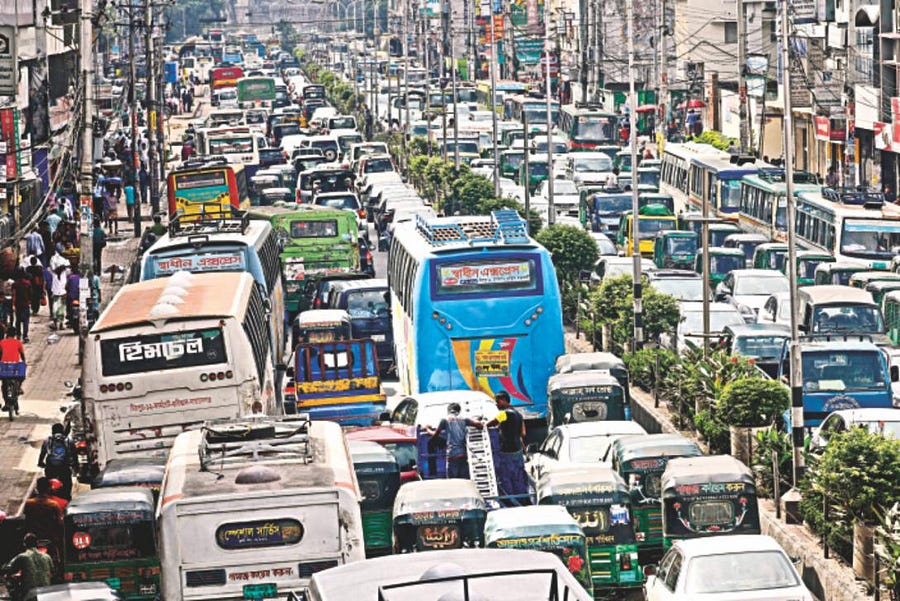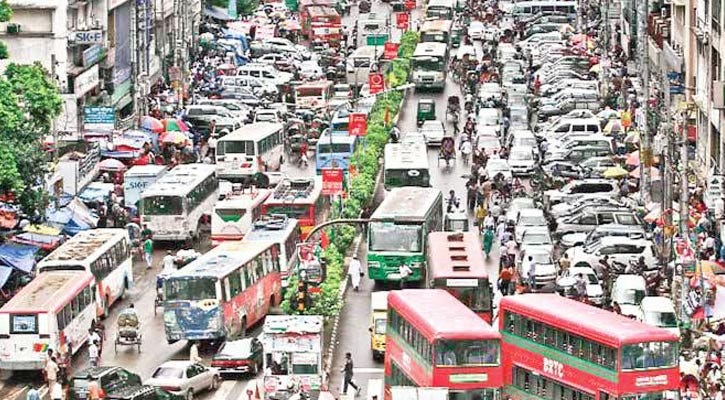The most traffic congested city is not what you think

I have traveled most of the major cities in the world. I have been stuck in traffic for hours in the worst traffic cities. But the real world-class traffic jam, I have seen in one city that is not Mexico City or Bangkok; that is Dhaka, the capital city of Bangladesh.
Navigation companies define a traffic congestion level “increase in overall traffic times when compared to a free flow situation (an uncongested situation).” The GPS producers company TomTom has conducted a survey of over 390 cities in different continents and made a ranking according to congestion level.
According to TomTom, Mexico City ranks first with a congestion level of 66% closely followed by Bangkok with a level of 61%. Forbes Magazine has made a list of worst traffic cities and Mexico City and Bangkok are again number one and two respectively.
Some other navigation companies and environmental organizations also have conducted similar surveys. All surveys find Mexico City and Bangkok within the top three.
I don’t know Mexico city that well but I have frequently visited Bangkok. I have been in Bangkok traffics many hours a day. Bangkok is undoubtedly one of the most traffic congested cities. But I can guarantee that Bangkok is not the most traffic-congested city.
I have been to Bangkok, Mumbai and New Delhi, but have never seen anything like the traffic chaos that I saw in Dhaka.

Last year, I had just landed in Dhaka from my trip to Dubai. After traveling a distance of 3,547km in just four hours, it took me another four hours to travel a distance of 16km in Dhaka from the airport to my hotel in Motijheel.
I encountered a traffic jam that remained at a standstill for many hours, worse than the worst jams in Bangkok. During my stay in Bangkok, I had never been stuck in traffic for over 45 minutes, as was the case in Dhaka while traveling to my hotel.
The following day I had two meetings to attend, but managed to visit only one although I was late and missed the second meeting because of traffic gridlock in the city. I also witnessed cars going in the opposite direction on a one-way route.
My driver told me that this was a common phenomenon. And when ministers’ convoys are about to pass, all vehicles are expected to stop and provide the way for the VIPs. This does not happen in Bangkok. It is hard to schedule more than one meeting amidst this horrible situation. Most people seem to have resigned to this sad state of affairs and schedule only one meeting a day.
The Greater Dhaka area is home to over 18 million people as of 2016. The density of Dhaka is 23,234 people for every square kilometer. Road networks constitute about eight percent of the city, and hawkers occupy large portions of this.
Based on Forbes estimates, the extra rush hour time in Bangkok is 57 percent, but for Dhaka, it is not projected. After experiencing extra travel time of about 4–5 hours in Dhaka City, I talked to experts on this issue.
Professor Mohammed Akhter from Urban Planning Development approximated extra travel time to be over 200 percent. A senior engineer from the roads and highways department echoed the same sentiment.
The extreme chaos associated with traffic jam affects general productivity in many sectors and poses negative consequences to the economy.
Bangladesh had enjoyed steady economic growth of about seven percent in the past years. This increase can be doubled by getting rid of traffic congestion, especially in Dhaka City. In 2015, it was estimated by the board of investment (now known as Bangladesh Investment Development Authority) in the country that the city faces a loss of about USD 12.56 billion each year because of the traffic jam.
Whereas extra consumption of fuel and wastage of working hours is measurable, the consequences for health, environment, and transportation of perishable products are hard to measure.
This is one of the reasons why there are varying figures on actual loss. For instance, UNDP approximates a lower loss of about USD 4.6 billion occurring from lost time, extra fuel and health.
The aggregate figure from seven studies (including universities like BUET) on loss resulting from gridlock is about USD 10 billion annually. Surprisingly, none of the seven studies have committed to research on lost working hours as a result of the traffic jam.
The majority of these studies have adopted estimates of World Bank of about 3.2 million hours that could have been spent at the workplace lost stuck in jam daily in Dhaka. The aggregate figure of USD 10 billion from seven research studies equates to almost five percent of Bangladesh’s GDP lost annually, and Dhaka generates 36 percent of national GDP.
There is no doubt that Bangladesh can double its GDP growth with the elimination of traffic jam in the city and in other major towns.
In the coming years, the situation may worsen because of slower traffic speed and increasing population of Dhaka City that is estimated to be 27 million by 2030.
The vast population plus slow traffic speed could result in more lost working hours unless the government plans on contingency measures. The losses arising from traffic jam can be considered more damaging to the city than anything else.
The actions to redeem the city from this never-ending gridlock have not proved to be adequate. More stakeholders need to join hands and enforce better measures that will stand the test of time.
( This story is the modified and updated version of my previously published article in The Daily Star)









